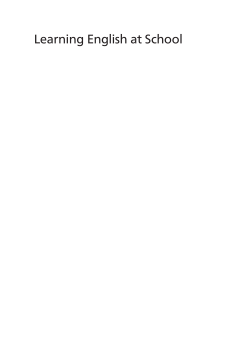
Additional Information
Book Details
Abstract
This fully revised edition provides a comprehensive discussion of how insights and concepts from new materialism and posthumanism might be used in investigating second language learning and teaching in classrooms. Alongside the sociocultural and poststructural perspectives discussed in the first edition, this new book presents insights from new materialism on identity, second language learning and pedagogical practices. This application of new theory deepens our understanding of how minority language background children learn English in the context of their classrooms. The author comprehensively explains the new materiality perspectives and suggests how research from this perspective might provide new insights on second language learning and teaching in classrooms. The book is unique in analysing empirical classroom data from a sociocultural, but also a new materiality perspective, and has the potential to change our understandings of research and pedagogical practices.
Kelleen Toohey is Professor Emerita, Faculty of Education, Simon Fraser University, Canada. Her recent research focuses on socio-material perspectives on language learning with a particular focus on early childhood language education. She is a co-author of Disrupting Boundaries in Education and Research (Cambridge University Press, 2017), Collaborative Research in Multilingual Classrooms (Multilingual Matters, 2009) and co-editor, with Bonny Norton, of Critical Pedagogies and Language Learning (Cambridge University Press, 2004).
In a world that needs new visions and ethics, this book stimulates important and original conversations. Theoretically grounded in new materialism Toohey rethinks classrooms as assemblages, joining the human and non-human as we take rides with pens on paper, follow fingers on iPads, and play with objects. This is a generous open-ended critical inquiry into the lives of children, complete with research stories from which we can all learn.
I read this book with a deep sense of appreciation for how children engage in and with socio-material worlds. It is the kind of writing and research that comes with years of experience in the field, observing teachers and young children in respectful, ethical and attentive ways. Toohey tells stories that celebrate and venerate children as complex and persistent feelers, makers and thinkers. It is a book that belongs on our book shelves.
Kelleen Toohey writes of her transition from her groundbreaking sociocultural studies to an engagement with emergent socio-material perspectives. The result is an important new vision for the field: at once theoretically generative while never losing focus on the lifeworlds of students, classrooms and their communities.
Table of Contents
| Section Title | Page | Action | Price |
|---|---|---|---|
| DOI https://doi.org/10.21832/TOOHEY0087 | iv | ||
| Contents | v | ||
| Acknowledgements for the Second Edition | ix | ||
| Introduction | 1 | ||
| 1 Framing Story: Theory, Setting and Methodology | 8 | ||
| 2 New Materialism and Language Learning | 25 | ||
| 3 Kindergarten Stories | 45 | ||
| 4 Constructing School Identities: Kindergarten | 87 | ||
| 5 ‘Break Them Up, Take Them Away’: Practices in the Grade 1 Classroom | 114 | ||
| 6 Discursive Practices in Grade 2: Language Arts Lessons | 137 | ||
| 7 Appropriating Voices and Telling Stories | 166 | ||
| References | 186 | ||
| Author Index | 200 | ||
| Subject Index | 204 |
